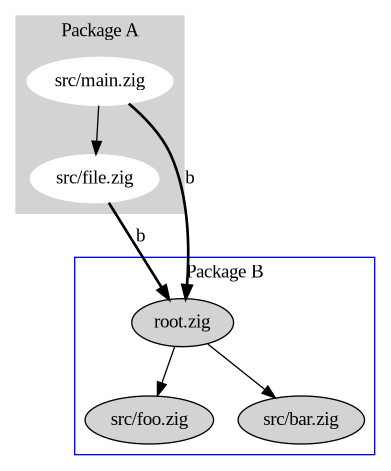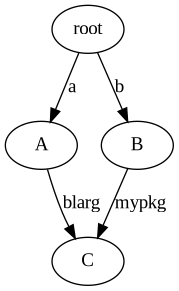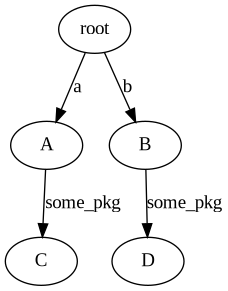@import and Packages
The @import() builtin is how you use code from outside your file. A
string literal is given as an argument and this is either a relative path
to another file or an arbitrary string configured to represent a package.
An important detail here is that the path case cannot reach above the
root file, so let's say we have the following filesystem:
map.zig
src/
main.zig
bar.zig
parser/
http.zig
foo/
blarg.zig
If your root file was src/main.zig, it could not import map.zig or
foo/blarg.zig, but src/parser/http.zig could import src/bar.zig by doing
@import("../bar.zig") because these are within the root's directory.
The special case for package strings that you're familiar with is "std" which the compiler configures for you automatically. Some examples of imports:
const std = @import("std"); // absolute classic
const mod = @import("dir/module.zig"); // import another file
const bad = @import("../bad.zig"); // not allowed
const pkg = @import("my_pkg"); // package import
The other major detail here is that @import() returns a type -- I like to
visualize
const mine = @import("my_file.zig");
as:
const mine = struct {
// contents of my_file.zig:
// pub const Int = usize;
// ...
};
And now you can access Int via mine.Int. This is leads to a cool pattern
where a file cleanly exports a struct by simply declaring members of a struct
in the root of a file:
const Mine = struct {
// contents of MyFile.zig:
// data: []const u8,
// num: usize,
// ...
};
The convention here is to use CapitalCase for the filename.
Packages
Packages are ultimately communicated to the zig compiler as command line
arguments, I will leave it to the reader to research --pkg-begin and
--pkg-end on their own. Instead I'll demonstrate what manual package
configuration in build.zig looks like -- at the end of the day, this work is
done for you by the package manager.
Every package is made up of one or more files, with one of them being the root.
All these files are connected through file imports, and any package imports
refer to the root file of another package. In the following figure we have
package A and B, made up of (src/main.zig, src/file.zig) and (root.zig,
src/foo.zig, src/bar.zig) respectively, and the files in package A import
B. Package imports are bold arrows with a label corresponding to the string
used in @import().

If we wanted to use package A in a program we wrote, we would have the
following in our build.zig:
const std = @import("std");
const Builder = std.build.Builder;
const Pkg = std.build.Pkg;
const pkg_a = Pkg{
.name = "a",
.path = "/some/path/to/src/main.zig",
.dependencies = &[_]Pkg{
Pkg{
.name = "b",
.path = "rel/path/to/root.zig",
.dependencies = null,
},
},
};
pub fn build(b: *Builder) !void {
const exe = b.addExecutable("my_program", "src/main.zig");
exe.addPackage(pkg_a);
}
So in order to use A, you need to tell it where to find "b", and this is nice
because it is trivial to drop a different implementation of package B. The
configuration for "b" only counts inside files belonging to package A, we will
not be able to import package B in our program, to do that we would need to
explicitly configure that relationship with another call to addPackage().
Each package has its own import namespace and this allows for situations where
different packages import the same code using different import strings:

and it allows for different packages to be referenced with the same string:

This makes for a simple and consistent medium in which to perform package management, where package resolution, replacement, and upgrading challenges are more about user experience rather than technical feasibility.